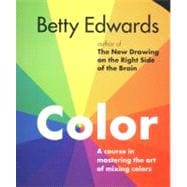
Note: Supplemental materials are not guaranteed with Rental or Used book purchases.
Purchase Benefits
What is included with this book?
| Acknowledgments | p. xi |
| Introduction: The Importance of Color | p. xiii |
| Drawing, Color, Painting, and Brain Processes | p. 2 |
| Seeing Colors as Values | p. 3 |
| Why Values Are Important | p. 4 |
| The Role of Language in Color and Painting | p. 6 |
| The Constancies: Seeing and Believing | p. 8 |
| Seeing How Light Changes Colors | p. 10 |
| Seeing How Colors Affect Each Other | p. 12 |
| Understanding and Applying Color Theory | p. 14 |
| Theories about Color | p. 15 |
| Applying Color Theory in Art | p. 17 |
| Learning the Vocabulary of Color | p. 20 |
| The Three Primary Colors | p. 21 |
| The Three Secondary Colors | p. 23 |
| The Six Tertiary Colors | p. 23 |
| Analogous Colors | p. 23 |
| Complementary Colors | p. 25 |
| Naming Colors: The L-Mode Role in Mixing Colors | p. 26 |
| The Three Attributes of Color: Hue, Value, and Intensity | p. 28 |
| From Naming to Mixing | p. 31 |
| Moving from Theory to Practice | p. 33 |
| Buying and Using Paints and Brushes | p. 36 |
| Buying Supplies | p. 37 |
| Beginning to Paint | p. 41 |
| Mixing a Color | p. 44 |
| Subjective Color | p. 45 |
| Cleaning Up | p. 47 |
| Using the Color Wheel to Understand Hue | p. 48 |
| Making a Color Wheel Template | p. 49 |
| Painting the Color Wheel | p. 51 |
| Practice in Identifying Hues | p. 56 |
| Mixing Colors | p. 57 |
| Creating Colors: How Four Pigments Can Become Hundreds of Colors | p. 57 |
| Using the Color Wheel to Understand Value | p. 60 |
| Value | p. 61 |
| Shades of Gray-Constructing a Value Wheel/Hue Scanner | p. 61 |
| How to Use Your Value Wheel/Hue Scanner | p. 63 |
| How to Lighten and Darken Colors | p. 64 |
| Two Color Value Wheels-From White to a Pure Hue, From a Pure Hue to Black | p. 65 |
| Other Ways of Lightening and Darkening Colors | p. 68 |
| Another Way to Darken a Color | p. 70 |
| Summing Up | p. 70 |
| Using the Color Wheel to Understand Intensity | p. 72 |
| The Power of the Primaries to Cancel Color | p. 73 |
| Creating an Intensity Wheel-From a Pure Hue to No Color and Back Again | p. 77 |
| Practice in Naming Hue, Value, and Intensity | p. 79 |
| Other Ways to Dull Colors | p. 80 |
| What Constitutes Harmony in Color? | p. 84 |
| The Aesthetic Response to Harmonious Color | p. 85 |
| The Phenomenon of After-images | p. 86 |
| After-images and the Attributes of Color | p. 90 |
| Albert Munsell's Theory of Harmony Based on Balancing Color | p. 92 |
| A Definition of Balanced Color | p. 93 |
| Creating Harmony in Color | p. 96 |
| Transforming Color Using Complements and the Three Attributes: Hue, Value, and Intensity | p. 96 |
| Seeing the Effects of Light, Color Constancy, and Simultaneous Contrast | p. 112 |
| The Next Step: Seeing How Light Affects the Colors of Three-Dimensional Shapes | p. 113 |
| Why It Is Difficult to See the Effects of Light | p. 115 |
| How to Accurately Perceive Colors Affected by Light | p. 116 |
| Three Different Methods of Scanning a Hue | p. 116 |
| The Next Step: Estimating the Intensity Level | p. 118 |
| The Three-Part Process of Painting | p. 119 |
| Painting a Still Life | p. 121 |
| Seeing the Beauty of Color in Nature | p. 134 |
| Color Harmony in Flowers | p. 135 |
| Floral Painting in Art | p. 136 |
| Colors in Nature Differ from Colors of Human-Made Objects | p. 139 |
| Painting a Floral Still Life | p. 140 |
| Nature as a Teacher of Color | p. 155 |
| The Meaning and Symbolism of Colors | p. 156 |
| Attaching Names to Colors | p. 157 |
| Using Colors to Express Meaning | p. 158 |
| The Color of Human Emotions | p. 161 |
| Your Preferred Colors and What They Mean | p. 168 |
| Knowing Your Color Preferences and Your Color Expressions | p. 171 |
| The Symbolic Meanings of Colors | p. 172 |
| Practicing Your Understanding of the Meaning of Color | p. 188 |
| Using Your Color Knowledge | p. 190 |
| Glossary | p. 193 |
| Bibliography | p. 197 |
| Index | p. 199 |
| Table of Contents provided by Rittenhouse. All Rights Reserved. |
The New copy of this book will include any supplemental materials advertised. Please check the title of the book to determine if it should include any access cards, study guides, lab manuals, CDs, etc.
The Used, Rental and eBook copies of this book are not guaranteed to include any supplemental materials. Typically, only the book itself is included. This is true even if the title states it includes any access cards, study guides, lab manuals, CDs, etc.